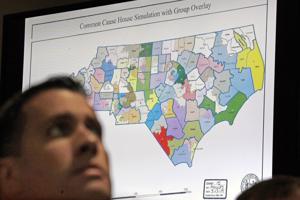North Carolina General Assembly gives new legislative maps initial nod

(The Center Square) – After several breaks, lengthy debate and a slew of amendments, the North Carolina General Assembly gave new legislative maps preliminary approval Tuesday.
As accusations of gerrymandering and a lawsuit loomed over the redistricting process, racial demographics of the state led to debate over Senate district lines.
Before the Senate Committee on Redistricting and Elections approved the new district map Tuesday, committee co-chair Paul Newton, R-Cabarrus, made it a point to discuss how and when racial data could be used in considering where to draw district lines. The data is of grave significance because a federal court ordered the state to redraw 28 districts that were found to be racial gerrymanders in 2016.
Newton said the state now is in a tight spot. Voting advocates have sued because racial data was not used to draft the proposed maps. He said it contradicts the 2016 case that found the state’s maps were based on racial data.
“So just to be clear, they litigated to limit our ability to use racial data. We’re choosing as we did in 2019 not to use racial data, and now they’re litigating saying we shouldn’t use racial data,” Newton said.
The 2016 maps also were found unconstitutional by a court and were redrawn in 2019 because of partisan gerrymandering. Republican-led redistricting leadership also has said they did not consider partisan data in the drafting of the maps to safeguard the process.
The Southern Coalition for Social Justice and Common Cause filed a lawsuit Friday, asking a judge to stop the maps from being drafted without first examining racial data, which they said is a violation of the Voting Rights Act. The advocates said by excluding racial data, the Legislature doesn’t consider the needs of the majority-minority districts, which also violates the North Carolina Constitution. The Voting Rights Act prohibits redistricting plans that are discriminatory or have discriminatory outcomes, the U.S. Department of Justice said.
Senate Minority Leader Dan Blue, D-Wake, offered an alternative to using the racial data by maintaining districts where Black candidates have consistently received 50% plus one of the vote, but Blue’s amendment was stuck down.
The Princeton Gerrymandering Project gave the Senate map an F grade for fairness and a C grade for competitiveness.
House Minority Leader Robert Reives, D-Durham, also presented an amendment to the House legislative map that directs lawmakers to draft districts that first address the Voting Rights Act. It was rejected.
House Redistricting Chair Destin Hall, R-Caldwell, said even though they did not use racial or political data to construct the map that the House approved, 67-49, on Tuesday, the process was transparent. The Princeton Gerrymandering Project gave Hall’s overall map an F grade for fairness and a C grade for competitiveness.
House Democrats said they heard complaints from constituents about the lack of the public’s involvement in the process. A majority of the changes Democrats put forth in both the Senate and House committees also were rejected.
Many Democrats argued a nonpartisan or independent group should create redistricting plans. Rep. Linda Cooper-Suggs, D-Wilson, said taxpayers have had to foot the bill for the years of litigation against the state’s maps but get little input.
The Legislature must reconstruct the district maps every 10 years, corresponding with the release on U.S. census data. The 2020 census showed the state’s population grew by more than 888,000 residents.
The Senate voted, 27-22, to approve a map Tuesday that added a 14th congressional district, increasing the state’s representation in the U.S. House of Representatives. Princeton also gave the map an F grade.
Each map must be approved in both chambers of the General Assembly.
Disclaimer: This content is distributed by The Center Square


